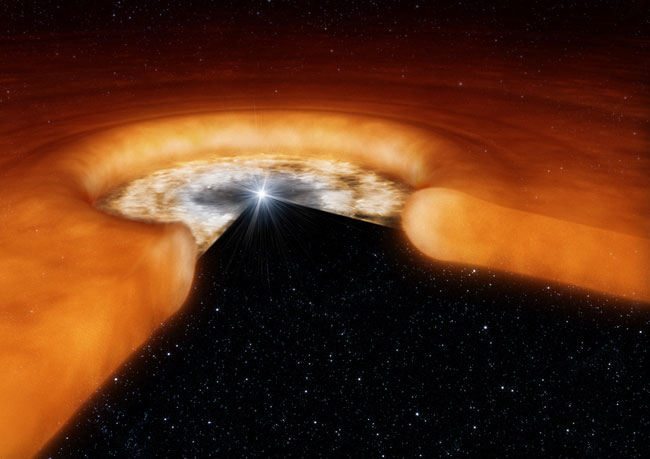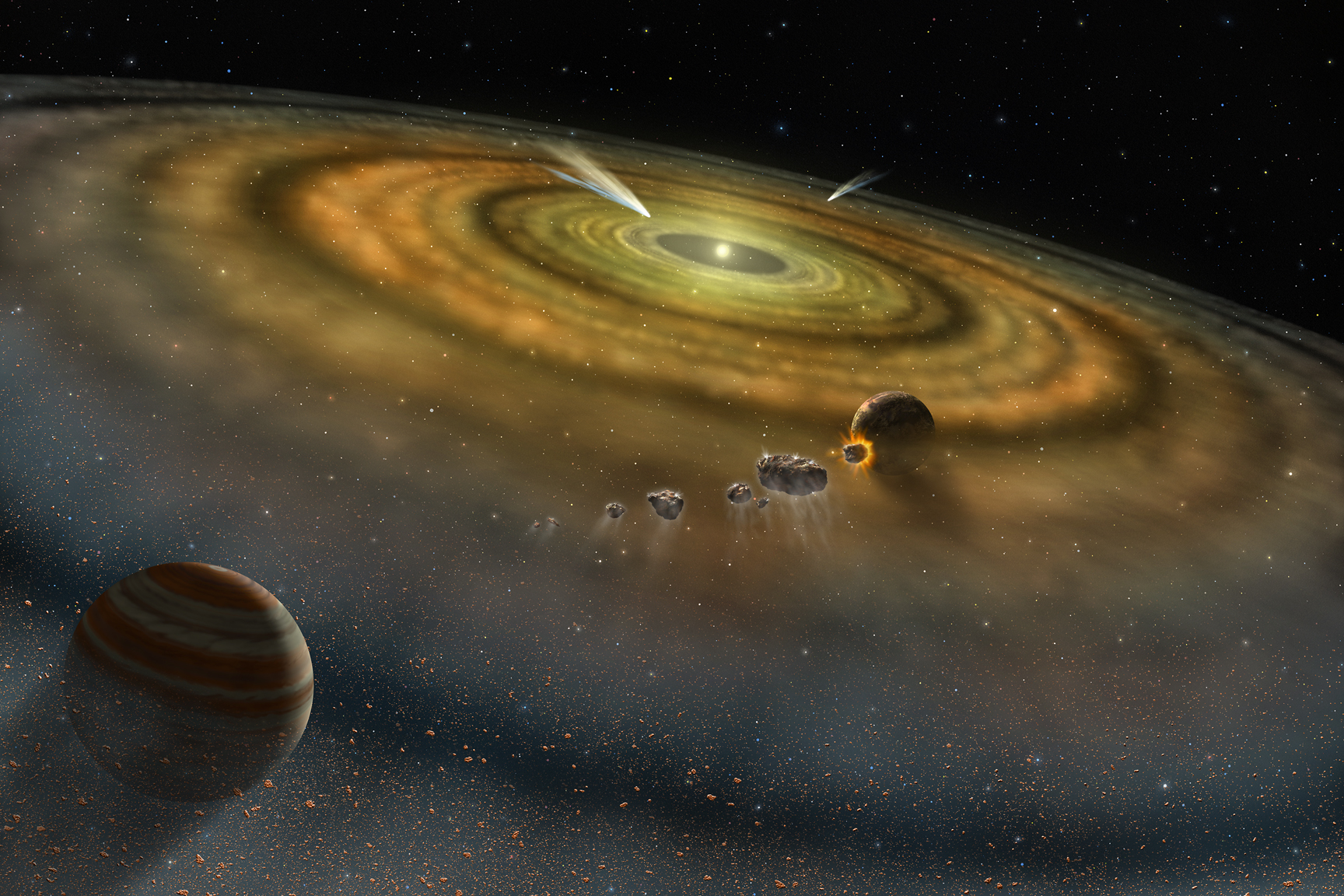Recent News
Dr. Avi M. Mandell

I am a civil servant research scientist in the Planetary Systems Laboratory (Code 693) at the NASA Goddard Space Flight Center. My research focuses on the formation and evolution of planetary systems, with the specific goal of understanding the factors that determine whether a system can form habitable planets and what the characteristics of these planets will be.
My primary research avenues are two-pronged: simulating terrestrial planet formation with increasing chemical and dynamical complexity, while improving observations of exo-planets and protoplanetary disks to constrain their properties. Descriptions of current and past research projects can be found on the research pages listed on the left.
I love discussing my work, and astrobiology and planetary formation in general, so if you have any questions or requests for more information don't hesitate to write!
Research Areas
Below is a short description of several areas of research that I work on. However, it's certainly not an exhaustive list - check my list of publications for a full account.
 Circumstellar Disk Observations
Circumstellar Disk ObservationsI use high-resolution infrared spectroscopy with telescopes such as the Keck Observatory and the Very Large Telescope to map the location of water and organic molecules in young circumstellar disks. By understanding the evolution of molecular gas in protoplanetary disks during the time period where planets are forming, we can better understand what determine's a planet's chemical composition.
 Exoplanet Observations
Exoplanet ObservationsI observe exoplanets as they pass in front and behind their parent star, using multi-wavelength observations to probe the composition and structure of the planets' atmospheres. Molecular absorption in the atmosphere of a planet provides both a measuring stick for how abundant that molecule is, but also allows us to determine the temperature of the atmosphere at different altitudes.
 Simulations of Planet Formation
Simulations of Planet FormationI develop computer simulations of the accretion of small bodies into full-sized rocky planets, in order to understand the evolution of planetary systems from dusty disks into multi-planet systems like our own. In particular, I have examined planet formation in systems with a migrating giant planet, and collaborated in several new theories on the role of giant planet migration in determining the size and composition of rocky planets.
Education
- Ph.D., The Pennsylvania State University, Astronomy and Astrophysics,
Dual Title in Astrobiology, 2007 - B.A., Vassar College, Physics and Astronomy, 1999
Professional Appointments
Research Scientist, NASA Goddard Space Flight Center, 2010 – Present
Research on the formation of planetary systems and the characterization of extrasolar planets from both an observational and theoretical perspective. Planning and operations for current and future instrumentation for space and ground-based telescopes.NASA Post-doctoral Fellow, NASA GSFC, 2007 – 2010
Near-IR spectroscopy of gas in circumstellar disks; NIR spectroscopic observations of exo-planet atmospheres; simulations of terrestrial planet formation in diverse system architecturesGraduate Assistant, Penn State University / NASA GSFC, 2001 – 2007
Near-IR spectroscopy of gas in circumstellar disks; simulations of planet formation in planetary systems with migrating giant planets; high-resolution spectroscopic searches for signatures of planet infall in exo-planet host starsPre-Doctoral Research/Teaching Fellow, Yale University, 1999 – 2001
Wide-field photometric search for transiting planets in old metal-rich open clusters
Selected Publications
Mandell, A. M., Bast, J., van Dishoeck, E. F., Blake, G. A., Salyk, C., Mumma M. J., & Villanueva, G. "First Detection of Near-infrared Line Emission from Organics in Young Circumstellar Disks". 2012, ApJ, 747, 92
Walsh, K. J., Morbidelli, A., Raymond, S. N., O'Brien, D. P., & Mandell, A. M. “A low mass for Mars from Jupiter’s early gas-driven migration”. Nature, 475, 206
Mandell, A. M., Deming, L. Drake, Blake, G. A., Knutson, H. A., Mumma, M. J., Villanueva, G. L., & Salyk, C. “Non-Detection of L-band Line Emission from the Exo-Planet HD189733b”. 2011, ApJ, 728, 18
Mumma, M. J., Villanueva, G. L., Novak, R. E., Hewagama, T., Bonev, B. P., DiSanti, M. A., Mandell, A. M., & Smith, M. D. “Strong Release of Methane on Mars in Northern Summer 2003”. 2009, Science, 323, 1041
Mandell, A. M. "Expanding and Improving the Search for Habitable Worlds". 2008, Astronomical Society of the Pacific Conference Series, 393, 19
Mandell, A. M., Mumma, M. J., Blake, G. A., Bonev, B. P., Villanueva, G. L., & Salyk, C. "Discovery of OH in Circumstellar Disks around Young Intermediate-Mass Stars". 2008, ApJL, 681, L25.
Mandell, A. M., Raymond, S. N., & Sigurdsson, S. "Formation of Earth-like Planets During and After Giant Planet Migration". 2007, ApJ, 660, 823.
Raymond, S. N. & Mandell, A. M. (co-primary author), & Sigurdsson, S. "Exotic Earths: Forming Habitable Worlds with Giant Planet Migration". 2006, Science, 313, 1413
Mandell, A. M., Ge, J., & Murray, N. "A Search for 6Li in Lithium-poor Stars With Planets". 2004, AJ, 127, 1147.
Mandell, A. M. & Sigurdsson, S. "Survival of Terrestrial Planets in the Habitable Zone in the Presence of Giant Planet Migration". 2003, ApJL, 599, L111.
Professional Activities
Local Organizing Committee Member, GSFC Signposts of Planets Conference,
2010
Contributing Author, Encyclopedia of Astrobiology, 2010
Member, SOC, NASA Astrobiology Inst. FAR Seminar Series, 2008
Session Chair, Astrobiology Science Conference 2008
Member, Astrobiology Society Founding & Early Career Committees, 2007
– Pres.
Member, American Astronomical Society, Division of Planetary Sciences


